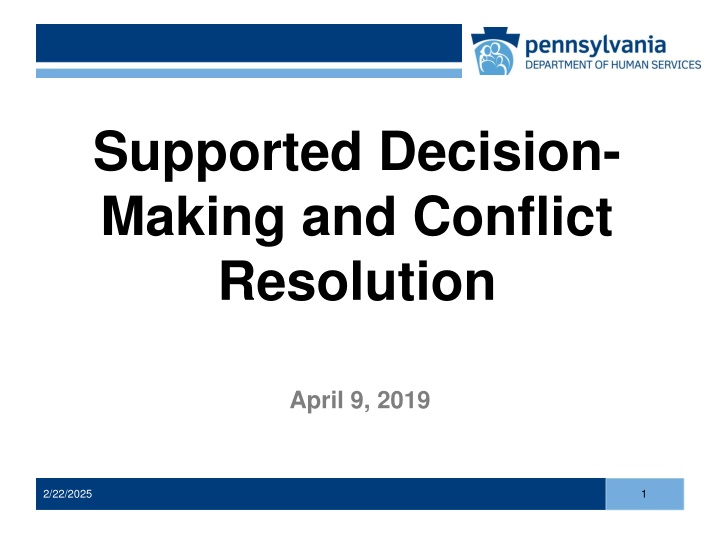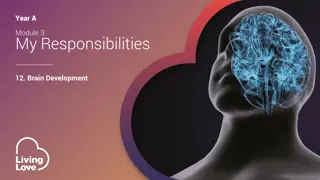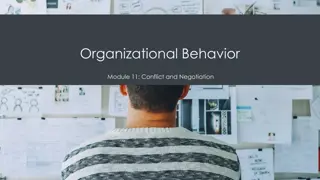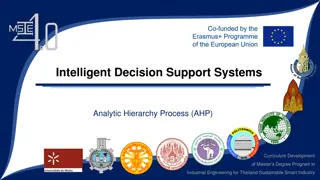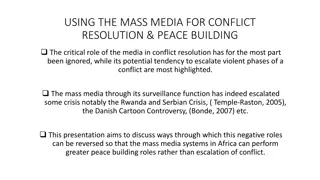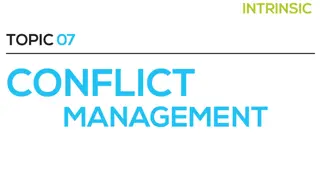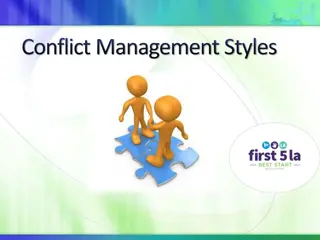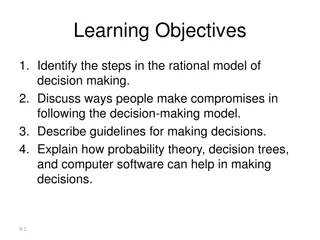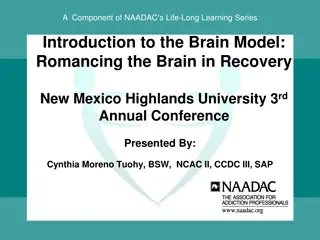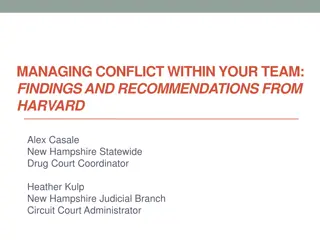Supported Decision-Making and Conflict Resolution
An overview of supported decision-making in relation to conflict resolution, exploring the importance of individual rights and decision-making processes within Chapter 6100 regulations. Understand the roles of decision-makers in safeguarding individual autonomy and involvement in decision-making.
Download Presentation

Please find below an Image/Link to download the presentation.
The content on the website is provided AS IS for your information and personal use only. It may not be sold, licensed, or shared on other websites without obtaining consent from the author.If you encounter any issues during the download, it is possible that the publisher has removed the file from their server.
You are allowed to download the files provided on this website for personal or commercial use, subject to the condition that they are used lawfully. All files are the property of their respective owners.
The content on the website is provided AS IS for your information and personal use only. It may not be sold, licensed, or shared on other websites without obtaining consent from the author.
E N D
Presentation Transcript
Supported Decision- Making and Conflict Resolution April 9, 2019 2/22/2025 1
How did we get here? Between September 2018 and February 2019, ODP received multiple requests from Supports Coordination Organizations, Administrative Entities, and providers for a presentation on guardianship. What everyone wanted to know was 2 2/22/2025
The Question Who is allowed to make decisions on an individual s behalf, and what types of decisions are allowed to be made? 3 2/22/2025
How did we get here? During the presentations, it became clear that what people really needed to know was 4 2/22/2025
The Core Question What do we do when nobody agrees? 5 2/22/2025
Decision- Making in Chapter 6100 6 2/22/2025
Chapter 6100 and Decision-Making There are many regulations in Chapter 6100 that relate to decision-making, the role of decision-makers, and individual rights. 7 2/22/2025
Chapter 6100 and Decision-Making 6100.181.(f) An individual who has a court- appointed legal guardian, or who has a court order restricting the individual s rights, shall be involved in decision- making in accordance with the court order. 8 2/22/2025
Chapter 6100 and Decision-Making 6100.182 (e) An individual has the right to make choices and accept risks. (f) An individual has the right to refuse to participate in activities and services. (g) An individual has the right to control the individual s own schedule and activities. (k) An individual has the right to choose where, when and how to receive needed services. (l) An individual has the right to voice concerns about the services the individual receives. (n) An individual has the right to participate in the development and implementation of the individual plan. 6100.183 (j) An individual has the right to make health care decisions. 9 2/22/2025
The Importance of Communication 6100.50. Communication. Written, oral and other forms of communication with the individual, and persons designated by the individual, shall occur in a language and means of communication understood by the individual or a person designated by the individual. 10 2/22/2025
Transitions Transitions 11 2/22/2025
Transitions Any transition can be difficult, but in cases where the transition involves moving into a completely different and unknown environment, these difficulties can be hard to predict and even harder to mitigate. For individuals where a Community Home will be their first time living away from their family home, transitions of this kind can precipitate unexpected difficulties for everyone involved. For both the individual and his/her family, this first experience with independence can be difficult, even when both the individual and the family are absolutely committed to the transition. 12 2/22/2025
Transitions Consider a young adult going away to college for the first time and the difficulties inherent to that life change. Parents often feel abandoned or guilty because they no longer provide support in all of the ways they had previously. In some cases parents respond to this by attempting to exert additional control over the young adult, especially if they perceive that the experiment with independence is not going well. 13 2/22/2025
Transitions The young adult in this situation may be exhilarated by the lack of direct parental control and often makes risky decisions due to this newfound freedom. Also, the young adult may gain weight, adopt poor sleep or hygiene habits, or have poor work ethic. Any attempt by the parent to exert control in these areas will likely be perceived by the young adult as infringing on his/her newfound independence. 14 2/22/2025
Transitions The difficulties are magnified when the circumstances of this common life event are applied to the transition of an individual with a disability from his/her family home to a Community Home. 15 2/22/2025
Transitions The young adult likely was at various times much more dependent on his/her parents due to their disability than a neurotypical child may have been. Individuals with disabilities are less likely to have strong bonds with peers outside of their families and paid supporters, further increasing reliance on those strong bonds that do exist. 16 2/22/2025
The UBEAM Method Understand Brainstorm Educate Apply and Analyze Modify 17 2/22/2025
Understand What is causing the conflict? History Perception Communication 18 2/22/2025
Brainstorm How can we mitigate resistance to new experiences? Risk mitigation Gradual introduction plans Desensitization 19 2/22/2025
Risk Mitigation Risk factors are conditions or habits that have the potential to result in a negative event. Risk Mitigation generally includes: Removal of exposure to a risk factor. Example: Choosing cleaning products that are not poisonous, regardless of an individual s ability to use, recognize, or avoid poisons. Reducing exposure to a risk factor. Example: Developing a Restrictive Procedure Plan for an individual with Prader Willi that maximizes the person s ability to make food choices while limiting access to food at all times. Transferring high-risk options to options with lower risk. Example: Offering an individual with diabetes a sugar free cookie instead of a regular cookie. Educating individuals to be more safely exposed to the risk factor that cannot be removed, reduced, or transferred. Examples: Teaching a person about how to be safe in the kitchen around hot stoves; providing sexual education to a person who has begun to have relationships of this nature. 20 2/22/2025
Gradual Introduction Plans Gradual introduction plans involve progressive involvement in services, supports, and activities to explore a individual s level of interest and increased participation in same. Gradual introduction is useful to overcome resistance to participation resulting from fear of the unknown. 21 2/22/2025
Desensitization The 3 steps of desensitization: 1. Establish the things that cause anxiety. 2. Teach methods to associate feelings of relaxation to the things that cause anxiety. 3. Gradually expose the individual to the things that cause anxiety while using relaxation methods. 22 2/22/2025
Educate Help the individual understand why something is important and explain ideas to mitigate barriers. Risks associated with the decision. Impact to others. Describe the plan(s) that might lead to consensus. 23 2/22/2025
Apply and Analyze Implement the ideas and plans and determine what works and what does not work. Observation Trending Outcomes 24 2/22/2025
Modify Change the plan to remove the things that are not working and expand the things that are working. Short term changes Ongoing monitoring Long-term changes 25 2/22/2025
Scenarios Understand Brainstorm Educate Apply - Modify 2/22/2025 26
Questions and Discussion 2/22/2025 27
Thank you! 2/22/2025 28
